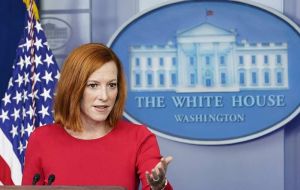MercoPress. South Atlantic News Agency
US will not release strategic reserve and Brent oil climbs to US$ 83 the barrel
 Goldman Sachs estimated that if the DoE released oil from the SPR, would likely be limited to just 60 million barrels. Goldman forecasts year end US$ 90 a barrel
Goldman Sachs estimated that if the DoE released oil from the SPR, would likely be limited to just 60 million barrels. Goldman forecasts year end US$ 90 a barrel  The Biden Administration will not make any predictions about releasing the SPR to alleviate high gasoline prices, Press Secretary Jen Psaki said
The Biden Administration will not make any predictions about releasing the SPR to alleviate high gasoline prices, Press Secretary Jen Psaki said  OPEC+ hasn’t heeded any calls from consuming nations and proceeded earlier this week with its plan to ease the cuts by the minimum 400,000 bpd
OPEC+ hasn’t heeded any calls from consuming nations and proceeded earlier this week with its plan to ease the cuts by the minimum 400,000 bpd By Julianne Geiger for Oilprice.com - The Unite States Department of Energy is walking back previous comments that it was considering a release of the Strategic Petroleum Reserve and a ban on crude oil exports, Bloomberg’s Javier Blas reported on Twitter.
According to Blas, the DoE isn’t considering tapping the SPR “at this time”. The news comes shortly after Goldman Sachs estimated that if the DoE released oil from the SPR, it would likely be limited to just 60 million barrels—posing a US$ 3 downside risk to its year-end US$ 90 barrel Brent forecast. A White House press briefing took a similar no-SPR tone.
The Biden Administration will not make any predictions about releasing the SPR to alleviate high gasoline prices, Press Secretary Jen Psaki said at the daily briefing on Wednesday.
Psaki instead focused on the climate crisis, commenting on the fact that the matter was so urgent that it could not wait any longer. “I’m not going to make any prediction of that from here.”
The press secretary noted that the Administration took steps in the aftermath of Hurricane Ida, including by authorizing exchanges from the SPR with oil and refining firms.
“We’ve also taken steps into, including engaging with members of OPEC,” Psaki said.
“But I’m not going to make any other predictions at this point in time. We’re continuously monitoring. We’ll look to take additional steps as needed,” she added.
“Certainly, we all want to keep gasoline prices low, but the threat of the crisis — the climate crisis — certainly can’t wait any longer,” Psaki said, commenting on whether other governments would get ‘weak-kneed’ about going green in the face of soaring energy prices, as the world leaders are preparing for the COP26 climate summit in the UK in November.
In recent months, the White House has been in contact with OPEC over the price of oil. National Security Advisor Jake Sullivan said in early August that the OPEC+ timeline for easing the cuts “is simply not enough” at a critical moment in the global recovery.
At the end of September, Psaki said “I would assure you we’re not only engaged with OPEC, we’re looking at every means we have to lower gas prices.”
The OPEC+ group hasn’t heeded any calls from consuming nations and proceeded earlier this week with its plan to ease the cuts by the minimum 400,000 bpd the market expected.
Meanwhile, the average U.S. gasoline price rose to the highest level since October 2014, , on the back of higher crude oil prices and higher demand. As of October 7, the average U.S. gasoline price stood at US$ 3.244 a gallon, as per AAA data.
Crude oil prices fell on Wednesday when Energy Secretary Granholm suggested that the U.S. was considering a release of crude oil from the SPR and a ban on crude exports. However on Thursday Brent was up 1,02% to US$ 82,97




Top Comments
Disclaimer & comment rulesCommenting for this story is now closed.
If you have a Facebook account, become a fan and comment on our Facebook Page!